模块20.Map集合
1
2
3
4
5
6
7
8
9
10
11
12
13
14
15
16
17
18
19
20
21
22
23
24
25
26
27
28
29
30
31
32
33
34
35
36
37
38
39
40
41
42
43
|
模块19回顾:
1.Collections集合工具类
方法:
addAll-> 批量添加元素
shuffle-> 元素打乱
sort->排序-> ascii
sort(集合,比较器)-> 按照指定的顺序排序
2.泛型:
a.含有泛型的类:
public class 类名<E>{}
new对象的时候确定类型
b.含有泛型的方法:
修饰符 <E> 返回值类型 方法名(E e){}
调用的时候确定类型
c.含有泛型的接口
public interface 接口名<E>{}
在实现类的时候确定类型
在实现类的时候还没有确定类型,只能new对象的时候确定
d.泛型通配符
<? extends 类型> ?接收的泛型类型是后面类的本类以及子类
<? super 类型> ?接收的泛型类型是后面类的本类以及父类
3.哈希值:计算机计算出来的十进制数,可以看成是对象的地址值
a.要是没有重写hashCode方法,默认调用Object中的hashCode方法,计算的是对象的哈希值
b.要是重写了hashCode方法,计算的是对象内容的哈希值
4.HashSet集合
特点: 元素唯一 无序 无索引 线程不安全
数据结构: 哈希表 = 数组+链表+红黑树
5.LinkedHashSet
特点:元素唯一 有序 无索引 线程不安全
数据结构: 哈希表+双向链表
6.set存储自定义对象怎么去重复 -> 重写hashCode和equals方法
7.去重复过程:先比较元素哈希值,再比较内容
如果哈希值不一样,存
如果哈希值一样,再比较内容->哈希值一样,内容不一样,存;哈希值一样,内容一样,去重复
模块20重点:
1.会使用HashMap和LinkedHashMap以及知道他们的特点
2.会使用Properties属性集
3.会操作集合嵌套
4.知道哈希表结构存储元素过程
|
第一章.Map集合
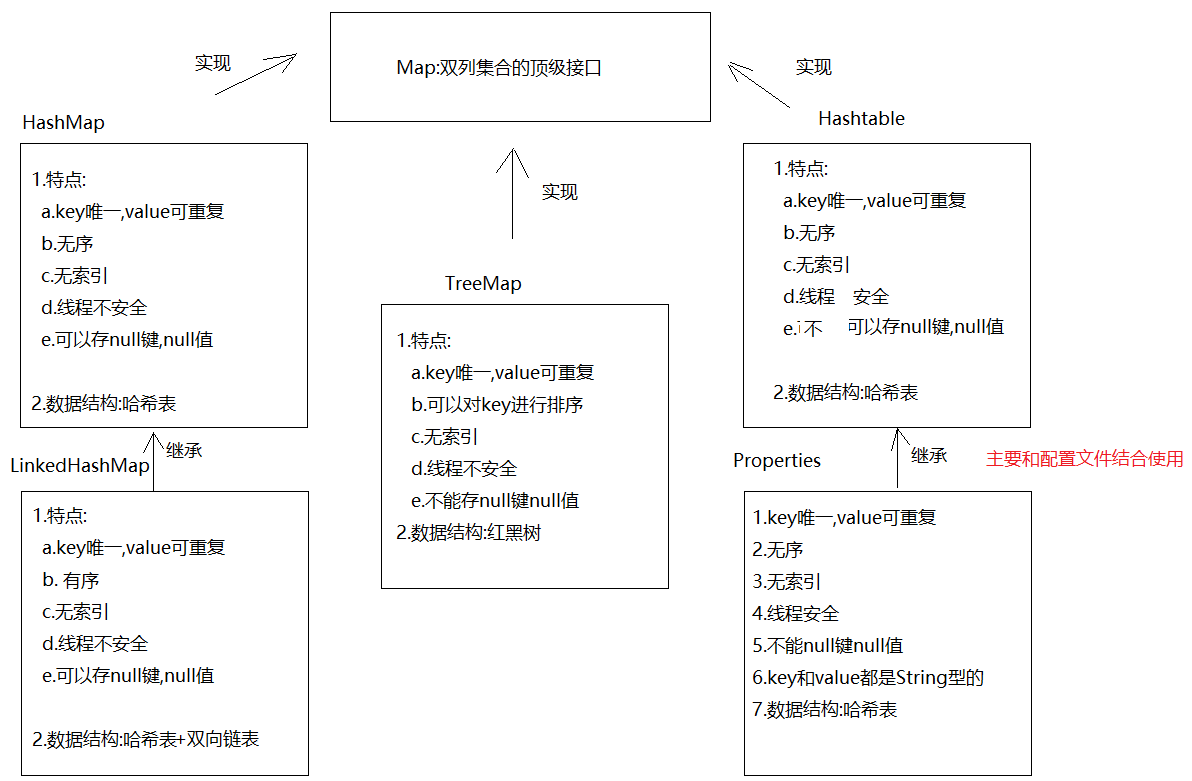
1.Map的介绍
1
2
3
|
1.概述:是双列集合的顶级接口
2.元素特点:
元素都是由key(键),value(值)组成 -> 键值对
|
2.HashMap的介绍和使用
1
2
3
4
5
6
7
8
9
10
11
12
13
14
15
16
17
18
|
1.概述:HashMap是Map的实现类
2.特点:
a.key唯一,value可重复 -> 如果key重复了,会发生value覆盖
b.无序
c.无索引
d.线程不安全
e.可以存null键null值
3.数据结构:
哈希表
4.方法:
V put(K key, V value) -> 添加元素,返回的是
V remove(Object key) ->根据key删除键值对,返回的是被删除的value
V get(Object key) -> 根据key获取value
boolean containsKey(Object key) -> 判断集合中是否包含指定的key
Collection<V> values() -> 获取集合中所有的value,转存到Collection集合中
Set<K> keySet()->将Map中的key获取出来,转存到Set集合中
Set<Map.Entry<K,V>> entrySet()->获取Map集合中的键值对,转存到Set集合中
|
1
2
3
4
5
6
7
8
9
10
11
12
13
14
15
16
17
18
19
20
21
22
23
24
25
26
27
28
29
30
|
public class Demo01HashMap {
public static void main(String[] args) {
HashMap<String, String> map = new HashMap<>();
//V put(K key, V value) -> 添加元素,返回的是被覆盖的value
String value1 = map.put("猪八", "嫦娥");
System.out.println(value1);
String value2 = map.put("猪八", "高翠兰");
System.out.println(value2);
System.out.println(map);
map.put("后裔","嫦娥");
map.put("二郎神","嫦娥");
map.put("唐僧","女儿国国王");
map.put("涛哥","金莲");
map.put(null,null);
System.out.println(map);
//V remove(Object key) ->根据key删除键值对,返回的是被删除的value
String value3 = map.remove("涛哥");
System.out.println(value3);
System.out.println(map);
//V get(Object key) -> 根据key获取value
System.out.println(map.get("唐僧"));
//boolean containsKey(Object key) -> 判断集合中是否包含指定的key
System.out.println(map.containsKey("二郎神"));
//Collection<V> values() -> 获取集合中所有的value,转存到Collection集合中
Collection<String> collection = map.values();
System.out.println(collection);
}
}
|
1
2
3
4
5
6
7
8
9
10
|
1.概述:LinkedHashMap extends HashMap
2.特点:
a.key唯一,value可重复 -> 如果key重复了,会发生value覆盖
b.有序
c.无索引
d.线程不安全
e.可以存null键null值
3.数据结构:
哈希表+双向链表
4.使用:和HashMap一样
|
1
2
3
4
5
6
7
8
9
10
|
public class Demo02LinkedHashMap {
public static void main(String[] args) {
LinkedHashMap<String, String> map = new LinkedHashMap<>();
map.put("八戒","嫦娥");
map.put("涛哥","金莲");
map.put("涛哥","三上");
map.put("唐僧","女儿国国王");
System.out.println(map);
}
}
|
3.HashMap的两种遍历方式
3.1.方式1:获取key,根据key再获取value
1
|
Set<K> keySet()->将Map中的key获取出来,转存到Set集合中
|
1
2
3
4
5
6
7
8
9
10
11
12
13
14
15
16
17
18
|
public class Demo03HashMap {
public static void main(String[] args) {
HashMap<String, String> map = new HashMap<>();
map.put("猪八", "嫦娥");
map.put("猪八", "高翠兰");
map.put("后裔","嫦娥");
map.put("二郎神","嫦娥");
map.put("唐僧","女儿国国王");
map.put("涛哥","金莲");
Set<String> set = map.keySet();//获取所有的key,保存到set集合中
for (String key : set) {
//根据key获取value
System.out.println(key+".."+map.get(key));
}
}
}
|
3.2.方式2:同时获取key和value
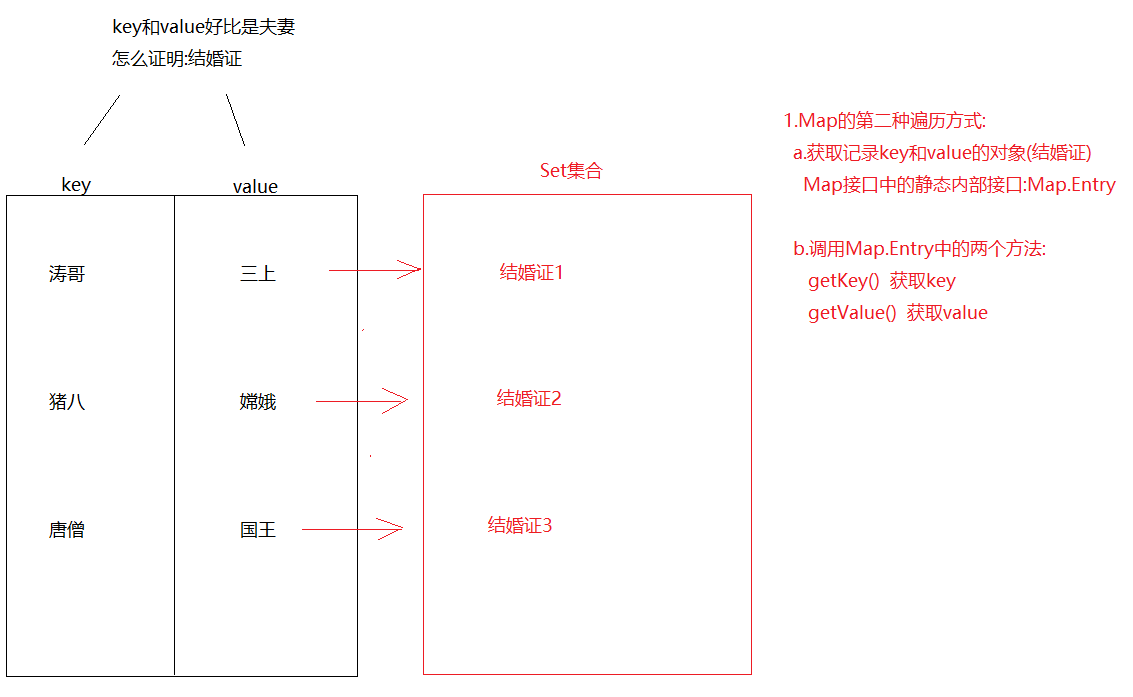
1
|
Set<Map.Entry<K,V>> entrySet()->获取Map集合中的键值对,转存到Set集合中
|
1
2
3
4
5
6
7
8
9
10
11
12
13
14
15
16
17
18
19
20
21
22
|
public class Demo04HashMap {
public static void main(String[] args) {
HashMap<String, String> map = new HashMap<>();
map.put("猪八", "嫦娥");
map.put("猪八", "高翠兰");
map.put("后裔","嫦娥");
map.put("二郎神","嫦娥");
map.put("唐僧","女儿国国王");
map.put("涛哥","金莲");
/*
Set集合中保存的都是"结婚证"-> Map.Entry
我们需要将"结婚证"从set集合中遍历出来
*/
Set<Map.Entry<String, String>> set = map.entrySet();
for (Map.Entry<String, String> entry : set) {
String key = entry.getKey();
String value = entry.getValue();
System.out.println(key+"..."+value);
}
}
}
|
1.Map存储自定义对象时如何去重复
1
2
3
4
5
6
7
8
9
10
11
12
13
14
15
16
17
18
19
20
21
22
23
24
25
26
27
28
29
30
31
32
33
34
35
36
37
38
39
40
41
42
43
44
45
46
47
48
49
|
public class Person {
private String name;
private Integer age;
public Person() {
}
public Person(String name, Integer age) {
this.name = name;
this.age = age;
}
public String getName() {
return name;
}
public void setName(String name) {
this.name = name;
}
public Integer getAge() {
return age;
}
public void setAge(Integer age) {
this.age = age;
}
@Override
public String toString() {
return "Person{" +
"name='" + name + '\'' +
", age=" + age +
'}';
}
@Override
public boolean equals(Object o) {
if (this == o) return true;
if (o == null || getClass() != o.getClass()) return false;
Person person = (Person) o;
return Objects.equals(name, person.name) && Objects.equals(age, person.age);
}
@Override
public int hashCode() {
return Objects.hash(name, age);
}
}
|
1
2
3
4
5
6
7
8
9
|
public class Demo05HashMap {
public static void main(String[] args) {
HashMap<Person, String> map = new HashMap<>();
map.put(new Person("涛哥",18),"河北省");
map.put(new Person("三上",26),"日本");
map.put(new Person("涛哥",18),"北京市");
System.out.println(map);
}
}
|
1
2
|
如果key为自定义类型,去重复的话,重写hashCode和equals方法,去重复过程和set一样一样的
因为set集合的元素到了底层都是保存到了map的key位置上
|
2.Map的练习
1
2
3
4
5
6
7
8
9
|
需求:用Map集合统计字符串中每一个字符出现的次数
步骤:
1.创建Scanner和HashMap
2.遍历字符串,将每一个字符获取出来
3.判断,map中是否包含遍历出来的字符 -> containsKey
4.如果不包含,证明此字符第一次出现,直接将此字符和1存储到map中
5.如果包含,根据字符获取对应的value,让value++
6.将此字符和改变后的value重新保存到map集合中
7.输出
|
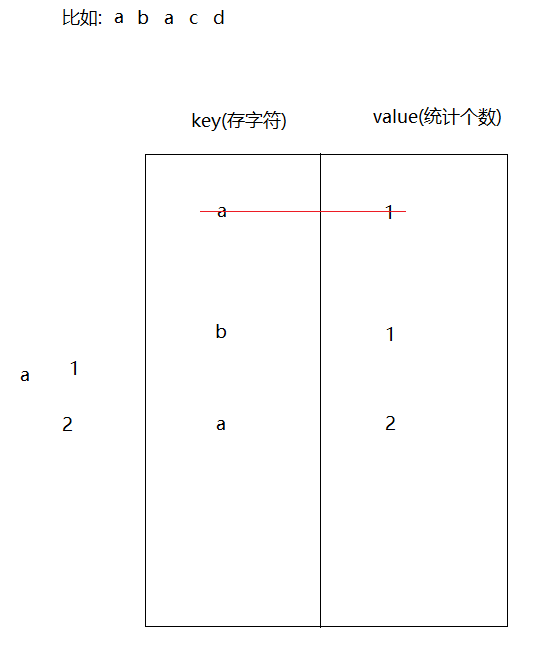
1
2
3
4
5
6
7
8
9
10
11
12
13
14
15
16
17
18
19
20
21
22
23
24
25
26
27
|
public class Demo06HashMap {
public static void main(String[] args) {
//1.创建Scanner和HashMap
Scanner sc = new Scanner(System.in);
HashMap<String, Integer> map = new HashMap<>();
String data = sc.next();
//2.遍历字符串,将每一个字符获取出来
char[] chars = data.toCharArray();
for (char aChar : chars) {
String key = aChar+"";
//3.判断,map中是否包含遍历出来的字符 -> containsKey
if (!map.containsKey(key)){
//4.如果不包含,证明此字符第一次出现,直接将此字符和1存储到map中
map.put(key,1);
}else{
//5.如果包含,根据字符获取对应的value,让value++
//6.将此字符和改变后的value重新保存到map集合中
Integer value = map.get(key);
value++;
map.put(key,value);
}
}
//7.输出
System.out.println(map);
}
}
|
3.斗地主_Map版本
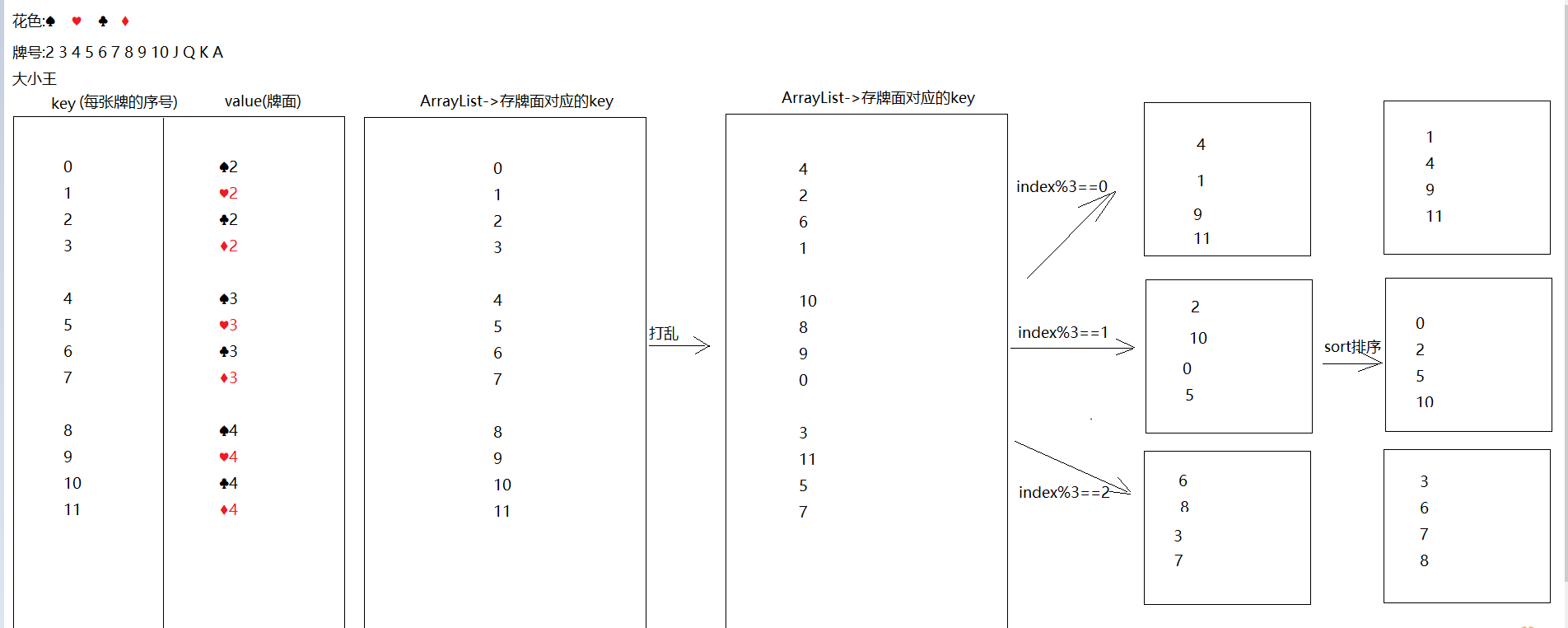
1
2
3
4
5
6
7
8
9
10
11
12
13
14
15
16
17
18
19
20
21
22
23
24
25
26
27
28
29
30
31
32
33
34
35
36
37
38
39
40
41
42
43
44
45
46
47
48
49
50
51
52
53
54
55
56
57
58
59
60
61
62
63
64
65
66
67
68
69
70
71
72
|
public class Demo07Poker {
public static void main(String[] args) {
//1.创建数组-> color -> 专门存花色
String[] color = "♠-♥-♣-♦".split("-");
//2.创建数组 -> number -> 专门存牌号
String[] number = "2-3-4-5-6-7-8-9-10-J-Q-K-A".split("-");
//3.创建map集合,key为序号,value为组合好的牌面
HashMap<Integer, String> poker = new HashMap<>();
//4.创建一个ArrayList,专门存储key
ArrayList<Integer> list = new ArrayList<>();
list.add(0);
list.add(1);
//5.组合牌,存储到map中
int key = 2;
for (String num : number) {
for (String huaSe : color) {
String pokerNumber = huaSe+num;
poker.put(key,pokerNumber);
list.add(key);
key++;
}
}
poker.put(0,"😊");
poker.put(1,"☺");
//6.洗牌,打乱list集合中的key
Collections.shuffle(list);
//7.创建四个list集合
ArrayList<Integer> p1 = new ArrayList<>();
ArrayList<Integer> p2 = new ArrayList<>();
ArrayList<Integer> p3 = new ArrayList<>();
ArrayList<Integer> dipai = new ArrayList<>();
//8.发牌
for (int i = 0; i < list.size(); i++) {
Integer key1 = list.get(i);
if (i>=51){
dipai.add(key1);
}else if (i%3==0){
p1.add(key1);
}else if (i%3==1){
p2.add(key1);
}else if (i%3==2){
p3.add(key1);
}
}
//9.排序
Collections.sort(p1);
Collections.sort(p2);
Collections.sort(p3);
Collections.sort(dipai);
lookPoker("涛哥",p1,poker);
lookPoker("三上",p2,poker);
lookPoker("金莲",p3,poker);
lookPoker("大郎",dipai,poker);
}
private static void lookPoker(String name, ArrayList<Integer> list, HashMap<Integer, String> map) {
System.out.print(name+":");
for (Integer key : list) {
String value = map.get(key);
System.out.print(value+" ");
}
System.out.println();
}
}
|
第二章.哈希表结构存储过程
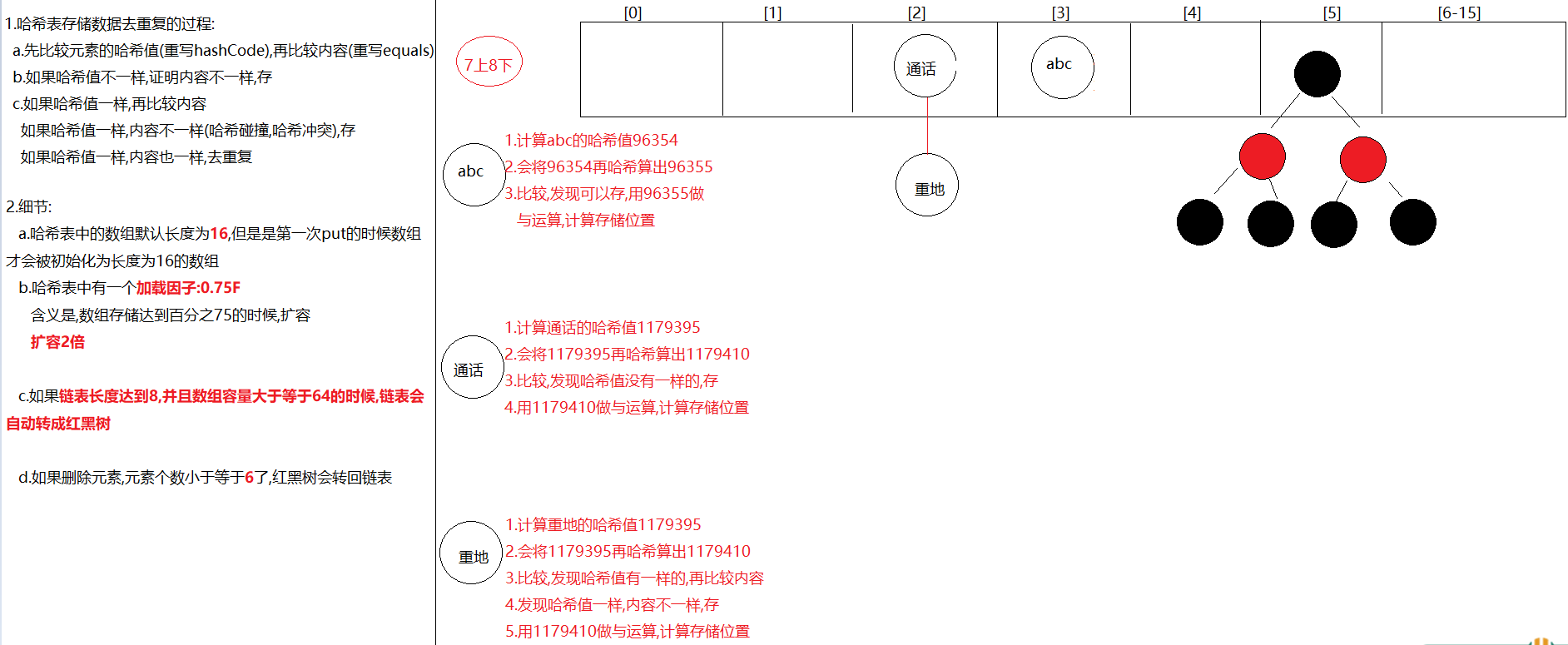
1
2
3
4
5
6
7
8
9
10
11
12
13
14
15
16
17
|
1.HashMap底层数据数据结构:哈希表
2.jdk7:哈希表 = 数组+链表
jdk8:哈希表 = 数组+链表+红黑树
3.
先算哈希值,此哈希值在HashMap底层经过了特殊的计算得出
如果哈希值不一样,直接存
如果哈希值一样,再去比较内容,如果内容不一样,也存
如果哈希值一样,内容也一样,直接去重复(后面的value将前面的value覆盖)
哈希值一样,内容不一样->哈希冲突(哈希碰撞)
4.要知道的点:
a.在不指定长度时,哈希表中的数组默认长度为16,HashMap创建出来,一开始没有创建长度为16的数组
b.什么时候创建的长度为16的数组呢?在第一次put的时候,底层会创建长度为16的数组
c.哈希表中有一个数据加[加载因子]->默认为0.75(加载因子)->代表当元素存储到百分之75的时候要扩容了->2倍
d.如果对个元素出现了哈希值一样,内容不一样时,就会在同一个索引上以链表的形式存储,当链表长度达到8并且当前数组长度>=64时,链表就会改成使用红黑树存储
如果后续删除元素,那么在同一个索引位置上的元素个数小于6,红黑树会变回链表
e.加入红黑树目的:查询快
|
1
2
3
4
5
6
|
外面笔试时可能会问到的变量
default_initial_capacity:HashMap默认容量 16
default_load_factor:HashMap默认加载因子 0.75f
threshold:扩容的临界值 等于 容量*0.75 = 12 第一次扩容
treeify_threshold:链表长度默认值,转为红黑树:8
min_treeify_capacity:链表被树化时最小的数组容量:64
|
1.问题:哈希表中有数组的存在,但是为啥说没有索引呢?
哈希表中虽然有数组,但是set和map却没有索引,因为存数据的时候有可能在同一个索引下形成链表,如果2索引上有一条链表,那么我们要是按照索引2获取,咱们获取哪个元素呢?所以就取消了按照索引操作的机制
2.问题:为啥说HashMap是无序的,LinkedHashMap是有序的呢?
原因:HashMap底层哈希表为单向链表

LinkedHashMap底层在哈希表的基础上加了一条双向链表

1.HashMap无参数构造方法的分析
1
2
3
4
5
|
//HashMap中的静态成员变量
static final float DEFAULT_LOAD_FACTOR = 0.75f;
public HashMap() {
this.loadFactor = DEFAULT_LOAD_FACTOR; // all other fields defaulted
}
|
解析:使用无参数构造方法创建HashMap对象,将加载因子设置为默认的加载因子,loadFactor=0.75F。
2.HashMap有参数构造方法分析
1
2
3
4
5
6
7
8
9
10
11
12
13
14
|
HashMap(int initialCapacity, float loadFactor) ->创建Map集合的时候指定底层数组长度以及加载因子
public HashMap(int initialCapacity, float loadFactor) {
if (initialCapacity < 0)
throw new IllegalArgumentException("Illegal initial capacity: " +
initialCapacity);
if (initialCapacity > MAXIMUM_CAPACITY)
initialCapacity = MAXIMUM_CAPACITY;
if (loadFactor <= 0 || Float.isNaN(loadFactor))
throw new IllegalArgumentException("Illegal load factor: " +
loadFactor);
this.loadFactor = loadFactor;
this.threshold = tableSizeFor(initialCapacity);//10
}
|
解析:带有参数构造方法,传递哈希表的初始化容量和加载因子
- 如果initialCapacity(初始化容量)小于0,直接抛出异常。
- 如果initialCapacity大于最大容器,initialCapacity直接等于最大容器
- MAXIMUM_CAPACITY = 1 « 30 是最大容量 (1073741824)
- 如果loadFactor(加载因子)小于等于0,直接抛出异常
- tableSizeFor(initialCapacity)方法计算哈希表的初始化容量。
- 注意:哈希表是进行计算得出的容量,而初始化容量不直接等于我们传递的参数。
3.tableSizeFor方法分析
1
2
3
4
5
6
7
8
9
10
11
|
static final int tableSizeFor(int cap) {
int n = cap - 1;
n |= n >>> 1;
n |= n >>> 2;
n |= n >>> 4;
n |= n >>> 8;
n |= n >>> 16;
return (n < 0) ? 1 : (n >= MAXIMUM_CAPACITY) ? MAXIMUM_CAPACITY : n + 1;
}
8 4 2 1规则->无论指定了多少容量,最终经过tableSizeFor这个方法计算之后,都会遵循8421规则去初始化列表容量为了存取高效,尽量较少碰撞
|
解析:该方法对我们传递的初始化容量进行位移运算,位移的结果是 8 4 2 1 码
- 例如传递2,结果还是2,传递的是4,结果还是4。
- 例如传递3,结果是4,传递5,结果是8,传递20,结果是32。
4.Node 内部类分析
哈希表是采用数组+链表的实现方法,HashMap中的内部类Node非常重要,证明HashSet是一个单向链表
1
2
3
4
5
6
7
8
9
10
11
|
static class Node<K,V> implements Map.Entry<K,V> {
final int hash;
final K key;
V value;
Node<K,V> next;
Node(int hash, K key, V value, Node<K,V> next) {
this.hash = hash;
this.key = key;
this.value = value;
this.next = next;
}
|
解析:内部类Node中具有4个成员变量
- hash,对象的哈希值
- key,作为键的对象
- value,作为值得对象(讲解Set集合,不牵扯值得问题)
- next,下一个节点对象
5.存储元素的put方法源码
1
2
3
|
public V put(K key, V value) {
return putVal(hash(key), key, value, false, true);
}
|
解析:put方法中调研putVal方法,putVal方法中调用hash方法。
- hash(key)方法:传递要存储的元素,获取对象的哈希值
- putVal方法,传递对象哈希值和要存储的对象key
6.putVal方法源码
1
2
3
|
Node<K,V>[] tab; Node<K,V> p; int n, i;
if ((tab = table) == null || (n = tab.length) == 0)
n = (tab = resize()).length;
|
解析:方法中进行Node对象数组的判断,如果数组是null或者长度等于0,那么就会调研resize()方法进行数组的扩容。
7.resize方法的扩容计算
1
2
3
4
5
6
7
8
9
|
if (oldCap > 0) {
if (oldCap >= MAXIMUM_CAPACITY) {
threshold = Integer.MAX_VALUE;
return oldTab;
}
else if ((newCap = oldCap << 1) < MAXIMUM_CAPACITY &&
oldCap >= DEFAULT_INITIAL_CAPACITY)
newThr = oldThr << 1; // double threshold
}
|
解析:计算结果,新的数组容量=原始数组容量«1,也就是乘以2。
8.确定元素存储的索引
1
2
|
if ((p = tab[i = (n - 1) & hash]) == null)
tab[i] = newNode(hash, key, value, null);
|
解析:i = (数组长度 - 1) & 对象的哈希值,会得到一个索引,然后在此索引下tab[i],创建链表对象。
不同哈希值的对象,也是有可能存储在同一个数组索引下。
1
2
3
4
5
6
7
8
9
|
其中resize()扩容的方法,默认是16
tab[i] = newNode(hash, key, value, null);->将元素放在数组中 i就是索引
i = (n - 1) & hash
0000 0000 0000 0000 0000 0000 0000 1111->15
& 0&0=0 0&1=0 1&1=1
0000 0000 0000 0001 0111 1000 0110 0011->96355
--------------------------------------------------------
0000 0000 0000 0000 0000 0000 0000 0011->3
|
1
2
3
4
5
|
0000 0000 0000 0000 0000 0000 0000 1111->15
& 0&0=0 0&1=0 1&1=1
0000 0000 0001 0001 1111 1111 0001 0010->1179410
--------------------------------------------------------
0000 0000 0000 0000 0000 0000 0000 0010->2
|
9.遇到重复哈希值的对象
1
2
3
4
|
Node<K,V> e; K k;
if (p.hash == hash &&
((k = p.key) == key || (key != null && key.equals(k))))
e = p;
|
解析:如果对象的哈希值相同,对象的equals方法返回true,判断为一个对象,进行覆盖操作。
1
2
3
4
5
6
7
8
|
else {
for (int binCount = 0; ; ++binCount) {
if ((e = p.next) == null) {
p.next = newNode(hash, key, value, null);
if (binCount >= TREEIFY_THRESHOLD - 1) // -1 for 1st
treeifyBin(tab, hash);
break;
}
|
解析:如果对象哈希值相同,但是对象的equals方法返回false,将对此链表进行遍历,当链表没有下一个节点的时候,创建下一个节点存储对象.
第三章.TreeSet
1
2
3
4
5
6
7
8
|
1.概述:TreeSet是Set的实现类
2.特点:
a.对元素进行排序
b.无索引
c.不能存null
d.线程不安全
e.元素唯一
3.数据结构:红黑树
|
1
2
3
|
构造:
TreeSet() -> 构造一个新的空 set,该 set 根据其元素的自然顺序进行排序 -> ASCII
TreeSet(Comparator<? super E> comparator)构造一个新的空 TreeSet,它根据指定比较器进行排序
|
1
2
3
4
5
6
7
8
9
10
11
12
13
14
15
16
17
18
19
20
21
22
23
24
25
26
27
28
29
30
31
32
33
34
35
36
37
38
39
40
41
42
43
44
45
46
47
48
49
|
public class Person {
private String name;
private Integer age;
public Person() {
}
public Person(String name, Integer age) {
this.name = name;
this.age = age;
}
public String getName() {
return name;
}
public void setName(String name) {
this.name = name;
}
public Integer getAge() {
return age;
}
public void setAge(Integer age) {
this.age = age;
}
@Override
public String toString() {
return "Person{" +
"name='" + name + '\'' +
", age=" + age +
'}';
}
@Override
public boolean equals(Object o) {
if (this == o) return true;
if (o == null || getClass() != o.getClass()) return false;
Person person = (Person) o;
return Objects.equals(name, person.name) && Objects.equals(age, person.age);
}
@Override
public int hashCode() {
return Objects.hash(name, age);
}
}
|
1
2
3
4
5
6
7
8
9
10
11
12
13
14
15
16
17
18
19
20
21
22
|
public class Demo01TreeSet {
public static void main(String[] args) {
TreeSet<String> set1 = new TreeSet<>();
set1.add("c.白毛浮绿水");
set1.add("a.鹅鹅鹅");
set1.add("b.曲项向天歌");
set1.add("d.红掌拨清波");
System.out.println(set1);
System.out.println("=====================");
TreeSet<Person> set2 = new TreeSet<>(new Comparator<Person>() {
@Override
public int compare(Person o1, Person o2) {
return o1.getAge()-o2.getAge();
}
});
set2.add(new Person("柳岩",18));
set2.add(new Person("涛哥",12));
set2.add(new Person("三上",20));
System.out.println(set2);
}
}
|
第四章.TreeMap
1
2
3
4
5
6
7
8
|
1.概述:TreeMap是Map的实现类
2.特点:
a.对key进行排序
b.无索引
c.key唯一
d.线程不安全
e.不能存null
3.数据结构:红黑树
|
1
2
3
|
构造:
TreeMap() -> 使用键的自然顺序构造一个新的、空的树映射 -> ASCII
TreeMap(Comparator<? super E> comparator)构造一个新的、空的树映射,该映射根据给定比较器进行排序
|
1
2
3
4
5
6
7
8
9
10
11
12
13
14
15
16
17
18
19
20
21
22
23
24
25
26
27
28
29
30
31
32
33
34
35
36
37
38
39
40
41
42
43
44
45
46
47
48
49
|
public class Person {
private String name;
private Integer age;
public Person() {
}
public Person(String name, Integer age) {
this.name = name;
this.age = age;
}
public String getName() {
return name;
}
public void setName(String name) {
this.name = name;
}
public Integer getAge() {
return age;
}
public void setAge(Integer age) {
this.age = age;
}
@Override
public String toString() {
return "Person{" +
"name='" + name + '\'' +
", age=" + age +
'}';
}
@Override
public boolean equals(Object o) {
if (this == o) return true;
if (o == null || getClass() != o.getClass()) return false;
Person person = (Person) o;
return Objects.equals(name, person.name) && Objects.equals(age, person.age);
}
@Override
public int hashCode() {
return Objects.hash(name, age);
}
}
|
1
2
3
4
5
6
7
8
9
10
11
12
13
14
15
16
17
18
19
20
21
22
23
24
25
|
public class Demo02TreeMap {
public static void main(String[] args) {
TreeMap<String, String> map1 = new TreeMap<>();
map1.put("c","白毛浮绿水");
map1.put("a","鹅鹅鹅");
map1.put("b","曲项向天歌");
map1.put("d","红掌拨清波");
System.out.println(map1);
System.out.println("=============");
TreeMap<Person, String> map2 = new TreeMap<>(new Comparator<Person>() {
@Override
public int compare(Person o1, Person o2) {
return o1.getAge()-o2.getAge();
}
});
map2.put(new Person("柳岩",18),"北京");
map2.put(new Person("涛哥",12),"北京");
map2.put(new Person("三上",20),"北京");
System.out.println(map2);
}
}
|
第五章.Hashtable和Vector集合(了解)
1.Hashtable集合
1
2
3
4
5
6
7
8
|
1.概述:Hashtable是Map的实现类
2.特点:
a.key唯一,value可重复
b.无序
c.无索引
d.线程安全
e.不能存储null键,null值
3.数据结构:哈希表
|
1
2
3
4
5
6
7
8
9
10
11
|
public class Demo01Hashtable {
public static void main(String[] args) {
Hashtable<String, String> table = new Hashtable<>();
table.put("迪丽热巴","马尔扎哈");
table.put("古力娜扎","涛哥思密达");
table.put("古力娜扎","雷霆嘎巴");
table.put("玛卡巴卡","哈哈哈哈");
//table.put(null,null);
System.out.println(table);
}
}
|
HashMap和Hashtable区别:
相同点:元素无序,无索引,key唯一
不同点:HashMap线程不安全,Hashtable线程安全
HashMap可以存储null键null值;Hashtable不能
2.Vector集合
1
2
3
4
5
6
7
8
9
10
11
|
1.概述:Vector是List接口的实现类
2.特点:
a.元素有序
b.有索引
c.元素可重复
d.线程安全
3.数据结构:数组
4.源码分析:
a.如果用空参构造创建对象,数组初始容量为10,如果超出范围,自动扩容,2倍
b.如果用有参构造创建对象,如果超出了范围,自动扩容,扩的是老数组长度+指定的容量增强
|
1
2
3
4
5
6
7
8
9
10
|
public class Demo02Vector {
public static void main(String[] args) {
Vector<String> vector = new Vector<>();
vector.add("张三");
vector.add("李四");
for (String s : vector) {
System.out.println(s);
}
}
}
|
Vector底层源码分析
1
2
|
Vector() 构造一个空向量,使其内部数据数组的大小为 10,其标准容量增量为零
Vector(int initialCapacity, int capacityIncrement)使用指定的初始容量和容量增量构造一个空的向量
|
1
2
3
4
5
6
7
8
9
10
11
12
13
14
15
16
17
18
19
20
21
22
23
24
25
26
27
28
29
30
31
32
33
34
35
36
37
38
39
|
Vector<String> vector = new Vector<>();
public Vector() {
this(10);
}
public Vector(int initialCapacity->10) {
this(initialCapacity, 0);
}
public Vector(int initialCapacity->10, int capacityIncrement->0) {
super();
if (initialCapacity < 0)
throw new IllegalArgumentException("Illegal Capacity: "+
initialCapacity);
this.elementData = new Object[initialCapacity];//长度为0的数组
this.capacityIncrement = capacityIncrement;//0
}
=====================================================
vector.add("李四");-> 假设李四是第11个元素
public synchronized boolean add(E e) {
modCount++;
ensureCapacityHelper(elementCount + 1);
elementData[elementCount++] = e;
return true;
}
private void ensureCapacityHelper(int minCapacity->11) {
// overflow-conscious code
if (minCapacity - elementData.length > 0)
grow(minCapacity->11);
}
private void grow(int minCapacity->11) {
// overflow-conscious code
int oldCapacity = elementData.length;//10
int newCapacity = oldCapacity + ((capacityIncrement > 0) ?
capacityIncrement : oldCapacity);//10+10=20
if (newCapacity - minCapacity < 0)
newCapacity = minCapacity;
if (newCapacity - MAX_ARRAY_SIZE > 0)
newCapacity = hugeCapacity(minCapacity);
elementData = Arrays.copyOf(elementData, newCapacity);
}
|
1
2
3
4
5
6
7
8
9
10
11
12
13
14
15
16
17
18
19
20
21
22
23
24
25
26
27
28
29
30
31
32
33
34
35
36
|
Vector<String> vector = new Vector<>(10,5);
public Vector(int initialCapacity->10, int capacityIncrement->5) {
super();
if (initialCapacity < 0)
throw new IllegalArgumentException("Illegal Capacity: "+
initialCapacity);
this.elementData = new Object[initialCapacity];
this.capacityIncrement = capacityIncrement;//5
}
======================================================
vector.add("李四");-> 假设李四是第11个元素
public synchronized boolean add(E e) {
modCount++;
ensureCapacityHelper(elementCount + 1);
elementData[elementCount++] = e;
return true;
}
private void ensureCapacityHelper(int minCapacity->11) {
// overflow-conscious code
if (minCapacity - elementData.length > 0)
grow(minCapacity);
}
private void grow(int minCapacity->11) {
// overflow-conscious code
int oldCapacity = elementData.length;//10
int newCapacity = oldCapacity + ((capacityIncrement > 0) ?
capacityIncrement : oldCapacity);
if (newCapacity - minCapacity < 0)
newCapacity = minCapacity;
if (newCapacity - MAX_ARRAY_SIZE > 0)
newCapacity = hugeCapacity(minCapacity);
elementData = Arrays.copyOf(elementData, newCapacity);
}
|
第六章.Properties集合(属性集)
1
2
3
4
5
6
7
8
9
10
11
12
13
14
|
1.概述:Properties 继承自 Hashtable
2.特点:
a.key唯一,value可重复
b.无序
c.无索引
d.线程安全
e.不能存null键,null值
f.Properties的key和value类型默认为String
3.数据结构:哈希表
4.特有方法:
Object setProperty(String key, String value) -> 存键值对
String getProperty(String key) ->根据key获取value的
Set<String> stringPropertyNames() -> 获取所有的key,保存到set集合中,相当于keySet方法
void load(InputStream inStream) -> 将流中的数据加载到Properties集合中(IO部分讲)
|
1
2
3
4
5
6
7
8
9
10
11
12
13
14
15
16
|
public class Demo01Properties {
public static void main(String[] args) {
Properties properties = new Properties();
//Object setProperty(String key, String value) -> 存键值对
properties.setProperty("username","root");
properties.setProperty("password","1234");
System.out.println(properties);
//String getProperty(String key) ->根据key获取value的
System.out.println(properties.getProperty("username"));
//Set<String> stringPropertyNames() -> 获取所有的key,保存到set集合中,相当于keySet方法
Set<String> set = properties.stringPropertyNames();
for (String key : set) {
System.out.println(properties.getProperty(key));
}
}
}
|
第七章.集合嵌套
1.List嵌套List
1
|
需求:创建2个List集合,每个集合中分别存储一些字符串,将2个集合存储到第3个List集合中
|
1
2
3
4
5
6
7
8
9
10
11
12
13
14
15
16
17
18
19
20
21
22
23
24
25
26
27
28
29
30
31
|
public class Demo01ListInList {
public static void main(String[] args) {
ArrayList<String> list1 = new ArrayList<>();
list1.add("杨过");
list1.add("小龙女");
list1.add("尹志平");
ArrayList<String> list2 = new ArrayList<>();
list2.add("涛哥");
list2.add("金莲");
list2.add("三上");
/*
list中的元素是两个 ArrayList<String>
所以泛型也应该是 ArrayList<String>
*/
ArrayList<ArrayList<String>> list = new ArrayList<>();
list.add(list1);
list.add(list2);
/*
先遍历大集合,将两个小集合遍历出来
再遍历两个小集合,将元素获取出来
*/
for (ArrayList<String> arrayList : list) {
for (String s : arrayList) {
System.out.println(s);
}
}
}
}
|
2.List嵌套Map
1
|
1班级有第三名同学,学号和姓名分别为:1=张三,2=李四,3=王五,2班有三名同学,学号和姓名分别为:1=黄晓明,2=杨颖,3=刘德华,请将同学的信息以键值对的形式存储到2个Map集合中,在将2个Map集合存储到List集合中。
|
1
2
3
4
5
6
7
8
9
10
11
12
13
14
15
16
17
18
19
20
21
22
23
24
25
26
27
|
public class Demo02ListInMap {
public static void main(String[] args) {
//1.创建两个map集合
HashMap<Integer, String> map1 = new HashMap<>();
map1.put(1,"张三");
map1.put(2,"李四");
map1.put(3,"王五");
HashMap<Integer, String> map2 = new HashMap<>();
map2.put(1,"黄晓明");
map2.put(2,"杨颖");
map2.put(3,"刘德华");
//2.创建一个存储map集合的list集合
ArrayList<HashMap<Integer, String>> list = new ArrayList<>();
list.add(map1);
list.add(map2);
//3.先遍历list集合,再遍历map集合
for (HashMap<Integer, String> map : list) {
Set<Map.Entry<Integer, String>> set = map.entrySet();
for (Map.Entry<Integer, String> entry : set) {
System.out.println(entry.getKey()+"..."+entry.getValue());
}
}
}
}
|
3.Map嵌套Map
1
2
3
4
5
6
|
- JavaSE 集合 存储的是 学号 键,值学生姓名
- 1 张三
- 2 李四
- JavaEE 集合 存储的是 学号 键,值学生姓名
- 1 王五
- 2 赵六
|
1
2
3
4
5
6
7
8
9
10
11
12
13
14
15
16
17
18
19
20
21
22
23
24
25
|
public class Demo03MapInMap {
public static void main(String[] args) {
//1.创建两个map集合
HashMap<Integer, String> map1 = new HashMap<>();
map1.put(1,"张三");
map1.put(2,"李四");
HashMap<Integer, String> map2 = new HashMap<>();
map2.put(1,"王五");
map2.put(2,"赵六");
HashMap<String, HashMap<Integer, String>> map = new HashMap<>();
map.put("javase",map1);
map.put("javaee",map2);
Set<Map.Entry<String, HashMap<Integer, String>>> set = map.entrySet();
for (Map.Entry<String, HashMap<Integer, String>> entry : set) {
HashMap<Integer, String> hashMap = entry.getValue();
Set<Integer> set1 = hashMap.keySet();
for (Integer key : set1) {
System.out.println(key+"..."+hashMap.get(key));
}
}
}
}
|






